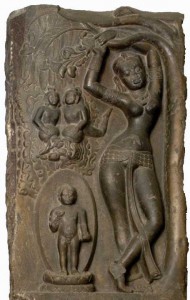Taken from an article distributed by Hua Zang Si on the occasion of the Bathing of the Buddha:

Queen Mahamaya is giving birth out of her right side to Prince Siddhartha of the Shakya clan who, upon becoming enlightened, became known as Shakyamuni Buddha. Prior to His birth, Queen Mahamaya had dreamt of a white elephant with six tusks and a white lotus flower in its mouth entering her womb. The tiny Prince Siddhartha is declaring Himself immediately after birth.
Around two thousand and five hundred years ago, located on wide plains on the north bank of the Rapti river in the southwest of what is now Nepal, there was an ancient kingdom called Kapilavatthu. At that time this area was part of India. The ruler, King Shuddhodana of the Shakya clan, and his wife, Queen Mahamaya, were the parents of Shakyamuni Buddha, the founder of Buddhism.
In the Spring of 623 BCE, while enjoying the beautiful scenery and walking under flowering sara trees at Lumbini Garden, Queen Mahamaya felt her birth pangs. As she held on to a branch of a sara tree, she soon gave birth to a Prince out of the right side of her torso as depicted in the bas relief on the left. During that time, celestial beings offered flowers, celestial kings offered clothes, the heavens played wonderful music, and nine dragons emitted water to bathe the Prince. After His birth, the Prince immediately walked and spoke. He took seven steps. Seven lotus blossoms sprung forth under each place where he stepped. With His right hand pointing towards the sky and the left hand pointing towards the ground as in the photo of the statue on the right, He said, “I am the only Honored one in the heavens and on earth.” He was known as Prince Siddhartha. The Prince became troubled by the scenes of birth, aging, sickness, death, and the sufferings of ordinary people. He decided to leave home and become a practitioner at the age of twenty-nine. After becoming a buddha, He continued expounding dharma for forty-five years. At the age of eighty, lying between two sala trees, He entered Nirvana.
On the holy birthday of Shakyamuni Buddha, followers who participate in the Dharma Assembly of Bathing the Buddha make offerings to establish their karmic conditions with the buddhas and also to wholeheartedly beseech the empowerment of the buddhas and to pray for peace and well being. While bathing the image of the Buddha with auspicious water, they vow to cultivate themselves in attaining the purity of their three karmas (body, speech, and mind) in the past, present, and future. They should receive the great and remarkable teachings and guidance of the buddhas and uphold the correct belief. They must do this without holding to any superstitious beliefs. In this way, they can correspond to the great and compassionate vows of the buddhas and attain accomplishment with the Bodhi state without regression. They should carry out the cultivation of a bodhisattva life after life until they attain the supreme enlightenment of a buddha.
